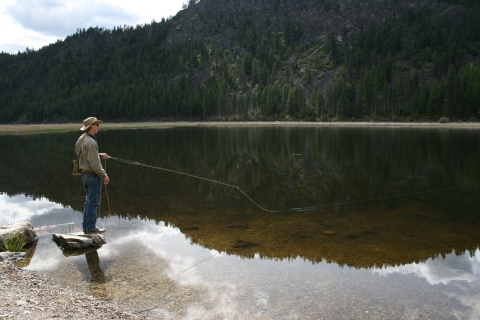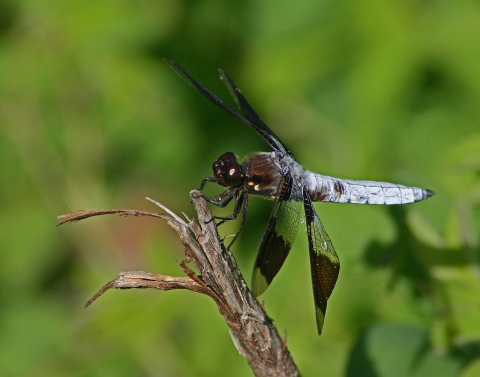About Us
The Little Pend Oreille, pronounced "ponderay," National Wildlife Refuge is located in northeastern Washington about 70 miles north of Spokane, 40 miles west from the panhandle of Idaho, and 40 miles south of British Columbia, Canada. Our 42,657 acres are within the Columbia River Basin Ecosystem and the Okanogan Highlands Province. The Refuge is on the western edge of the Sekirk Mountains; elevations range from 1,800 feet to 5,600 feet. Other public lands surround us- to the north the Washington Department of Natural Resources; to the east and south the U.S. Forest Service are the land stewards.
The Refuge was established on May 2, 1939 to protect and provide a breeding ground for migratory birds and other wildlife. Most of the land was acquired through the Resettlement Administration which retired marginal farmland. Other land was purchased from willing sellers or acquired through exchange with the Washington Department of Natural Resources.
Our Mission
The mission of the National Wildlife Refuge System is to administer a national network of lands and waters for the conservation, management and, where appropriate, restoration of the fish, wildlife and plant resources and their habitats within the United States for the benefit of present and future generations of Americans.
Every national wildlife refuge national wildlife refuge
A national wildlife refuge is typically a contiguous area of land and water managed by the U.S. Fish and Wildlife Service for the conservation and, where appropriate, restoration of fish, wildlife and plant resources and their habitats for the benefit of present and future generations of Americans.
Learn more about national wildlife refuge was created for a special purpose. Some were created to protect migratory birds, others to protect threatened or endangered species or unique habitats, while others fulfill another special purpose. All activities allowed on refuges must be evaluated to make sure each activity will not conflict with the reason the refuge was founded.
Goals
- Conserve, enhance, and restore native forest, riparian riparian
Definition of riparian habitat or riparian areas.
Learn more about riparian , in-stream, and wetland habitats and their associated fish, wildlife, and plants, representative of the native biological diversity of northeastern Washington. - Monitor, protect, and recover special status plants and animals and species of management interest.
- Provide opportunities for wildlife-dependent recreation and education to enhance public appreciation, understanding, and enjoyment of Refuge wildlife, fish, habitats, and cultural history.
Our History
The Refuge was established on May 2, 1939 to protect and provide a breeding ground for migratory birds and other wildlife.
- 1879 – 1931 - One hundred and eighty eight homestead claims were patented within what would later become the refuge boundary.
- 1935 - The Resettlement Administration classifies much of the land as “submarginal” due to short growing seasons, harsh winters, and overgrazed conditions. Most of the homesteads were acquired through the Soil Conservation Service by outright purchases or trades for parcels in more productive areas.
- 1939 - The Little Pend Oreille Wildlife Refuge is established by Executive Order signed by President Franklin D. Roosevelt.
- 1940 - Proclamation No. 2416 changes the name to Little Pend Oreille National Wildlife Refuge.
- 1965 - Washington Department of Game assumes management responsibility through a cooperative agreement with the U.S. Fish and Wildlife Service. The area becomes known locally as the “Game Range”.
- 1967 - A land exchange with the Washington Department of Natural Resources consolidated state and refuge ownerships. Federal lands on the northeastern part of the refuge were exchanged for state inholdings within the core of the refuge.
- 1994 - Prompted by an internal audit by the General Accounting Office, the agency resumes active management of the refuge.
- 2000 - Refuge Comprehensive Conservation Plan is completed, guiding refuge management into the future.
- 2014 - Refuge celebrates its 75th anniversary.
Other Facilities in this Complex
The Inland Northwest National Wildlife Refuge Complex comprises three refuges - Little Pend Oreille and Turnbull Refuges in northeast Washington and Kootenai Refuge in northern Idaho. We share work priorities, budgets and some staff. Turnbull Refuge is the complex headquarters.
Despite common management oversight, each of the three complex refuges is unique. Little Pend Oreille, at 42,657 acres, is a mountainous forested Refuge with clear streams, scattered lakes, and diverse outdoor pursuits; Turnbull, at 18,217 acres, features over 130 wetlands, ponderosa pine forest, steppe grassland, aspen, and rock set in a distinctive landscape that offers many possibilities for experiencing nature; Kootenai, at 2,774 acres, is a small gem of diverse wetland, cropland, and upland habitats and recreational opportunities.





